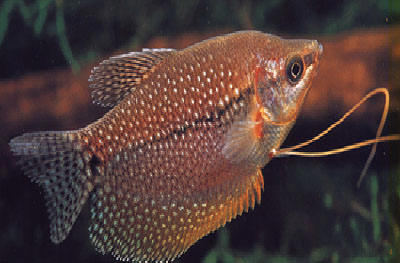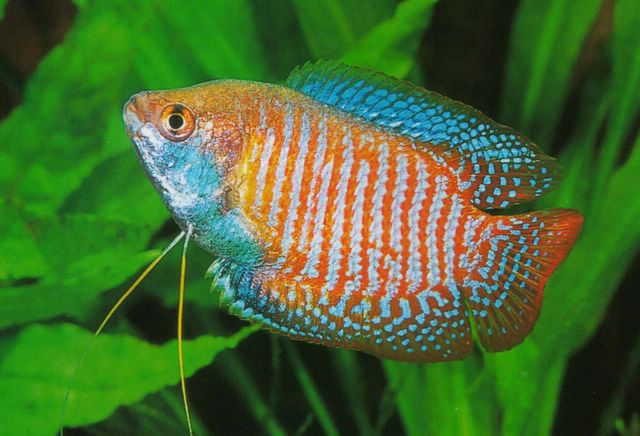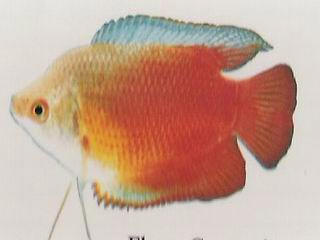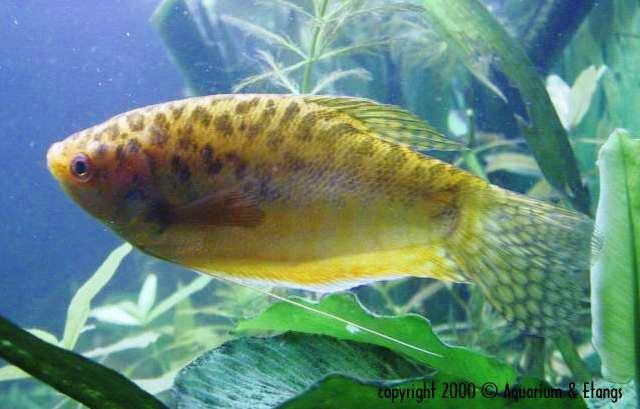| Data Sheet | | |
| Scientific Name: | Trichogaster trichopterus, | |
| Other Names: | Three Spot Gourami, Opaline Gourami, Cosby Gourami, Golden Gourami, Silver Gourami, Honey Gourami, Dwarf Gourami | |
| Family: | Belontiidae | |
| Origin: | South East Asia | |
| Adult Size: | 4.3 inches (11 cm) | |
| Social: | Peaceful with larger or same size fish. But may eat smaller fish. | |
| Lifespan: | 4 years | |
| Tank Level: | Top, middle dweller | |
| Minimum Tank Size: | 20 gallons | |
| Diet: | Omnivore - Eats most food | |
| Breeding: | Egg Layer - bubble nest builder | |
| Care: | Easy | |
| Ideal pH: | 6.8-7.5 | |
| Temperature: | 72-79 F (22-26 C) | Pink Kissing Gourami |
| Tank setup:
| Planted tank with some thick plants, and gentle circulation |
|
| Sexing: | The dorsal fin is long and pointed in males; in females it is shorter and rounded. | |
| | Description:Many gouramies have an elongated ray at the front of their pelvic fins. Many species show parental care. The three spot Gourami sports but two spots; one in the center of the body, and a second at the caudal pentacle (beginning of the tail). The third spot is actually the eye. Selective breeding has produced other types of gouramis, and some species lack the spots. Habitat/Care:Hailing from the tropical waters of the Far East, Blue Gouramis are one of the most hardy of the Gourami family. Their preference is for thickly vegetated waters of any type. They can be found in ditches, canals, ponds, swamps, rivers, and lakes. Blue Gouramis tolerate a wide range of temperatures and are not demanding in terms of water conditions. However, they prefer soft, slightly acidic water when in breeding season. Mixing with other fishes:In the home aquarium they may be housed with a variety of fish, although it's usually best to keep them with fish of similar size. Generally only one male should be kept per tank, as males are highly territorial. However if the tank is large enough, or there are enough other fish present, this natural tendency will be diminished. Diet:These are exceptionally easy fish to feed, as they will accept virtually any foods, from flake to freeze-dried, to live foods. They will consume hydra voraciously, and are prized for their ability to eliminate this pest from the home aquarium. |
Breeding:Sexes are primarily differentiated by the shape of the dorsal fin, which is long and pointed in males, compared to the females' shorter rounded dorsal. Females that are prepared for spawning will show a pronounced swelling in the breast area, while the male will have a far more slender girth. Both sexes display a much deeper blue color during breeding periods. Because the male can be rather aggressive during spawning, the aquarium habitat should provide ample places for the female to take refuge. Failure to do so can result in injury to the female. Spawning begins with the building of the bubble nest by the male, which usually occurs early in the day. After a suitable nest has been prepared, the male will attempt to entice the female under it by swimming back and forth, flaring his fins and raising his tail. The female signals her readiness by biting his back; he responds by repeatedly brushing his back against her belly before taking her into a spawning embrace. During spawning the male wraps his body tightly around the female, turning her on her side or back so the eggs will rise unimpeded to the surface. This close embrace is also important because it brings the reproductive products as close together as possible. Because sperm cells survive only a matter of minutes in the water, the timing of their release and proximity to the eggs is critical. Variants:
| |
Photo Galley
Got a photo? Contact me.
 Pearl Gourami |  Golden Gourami |  Blue Gourami |
 Three spot Gourami |  Kissing Gourami |  Giant Gourami |
| | | |
| | | |
Links to other awesome Gourami sites:
1. http://www.asianaquariums.com/anabantidpic.htm - an excellent photo galley.
2. http://www.greenparktropical.com/Fish/gourami.htm - a singaporean fish farm where they breed gourami for export.
References Cited:
1. Blue Gourami, [Online], Available http://freshaquarium.about.com/od/gourami/p/bluegourami.htm?terms=gourami
2. David Goodwin (2001), The Aquarium Fish Handbook, D & S books, England.
3. Pearl Gourami Profile [Online], Available http://badmanstropicalfish.com/profiles/profile30.html
4. Gourami [Online], Available http://en.wikipedia.org/wiki/Gourami
5. William Burg (??) Breeding Gourami, Online, Available http://petcaretips.net/breeding-gourami-fish.html
6. Kissing Gourami Information, [Online], Available http://www.timstropicals.com/Inventory/Gourami/KissingGouramiInfo.asp
7. Moonlight Gourami, [Online], Available http://freshaquarium.about.com/cs/anabantids2/p/moongourami.htm




























No comments:
Post a Comment